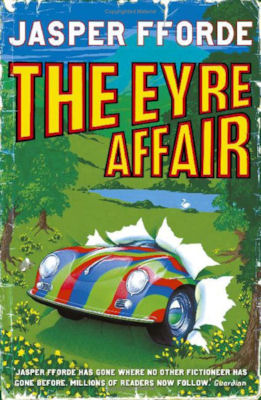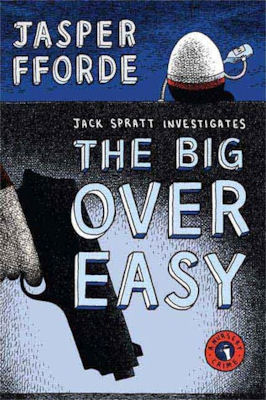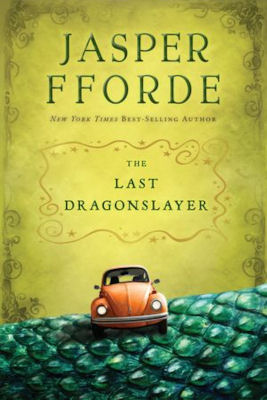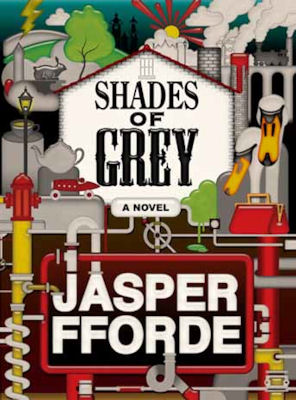It takes a certain sort of author to inspire an annual festival, doesn’t it?
It takes a certain sort of author to bring such unadulterated joy to his or her readers that they are compelled to come together each and every year — in a great city in the South West of England, for instance — the better to celebrate the craving for all things comic they share.
Since its commencement in 2005, the Fforde Fiesta has been home to any number of incredible events, including an interactive performance of Richard III, the first and alas the last live recording of everyone’s favourite game show, Celebrity Name That Fruit, and in the interim, guided tours of The Seven Wonders of Swindon. This year, one of the most memorable activities the volunteer organisers, uh, organised, was a march on ASDA. That’s the long arm of Walmart here in the U.K., incidentally; one supermarket to rule them all and all that.
All that, all this, and so much more besides: all to toast the works and the worlds of one writer. An odd thing in this day and age, I’m sure you’ll agree—but most definitely deserved, because Jasper Fforde, as I’ve endeavoured to establish beyond the merest suggestion of a shadow of doubt in the previous paragraphs, is… a certain sort of author.
Why, I couldn’t have put it better myself!
The thing about Fforde, though, is that he has four concurrent series on the go. This month alone saw the release of the seventh volume of his most singular saga: The Woman Who Died A Lot stars the former and presumably future literary detective Thursday Next, whose sublime shenanigans through time and text led, at the last, to the loss of her odd employment. It’s a terrific new novel, but if you haven’t read Fforde before, know now that this is not the introduction you deserve.
Nor, in all likelihood, will Fforde’s next book be, whether it’s a sequel at long last — or indeed a prequel — to Shades of Grey, or The Return of Shandar, which is to say the conclusion of the Dragonslayer trilogy.
What I’m saying is: if you aren’t already reading Jasper Fforde, you should be, but it can be difficult, as has become apparent, to determine where, exactly, and with what, one should start. This may or may not be because Fforde lives and works in Wales, the undisputed Kingdom of confusion, and home, of course, to the community of Llanfairpwllgwyngyllgogerychwyrndrobwllllantysiliogogogoch.
In any case, that’s what An Ode to Fforde is all about. It’s essentially a primer, not so much to help you make up your mind whether or not Jasper Fforde’s fiction is for you — if you ask me, and self-evidently somebody did, it’s for everyone — but rather to answer that eternal question: which of this imaginative madman’s many and various books would you be best to begin with?

The obvious answer is, obviously, The Eyre Affair. This, the first volume of the first of two ostensibly separate series featuring Thursday Next, was also the first of Fforde’s novels to be published, in 2001, and though legend has it that publishers rejected his eventual debut precisely 76 times, it’s hard to see why. Even now, eleven books later, it stands as a timeless testament to the very factors that have attracted such a devoted following to Fforde.
Amongst these factors, first and foremost, there’s the unadaulterated fun of it. Hardly anyone takes Thursday Next seriously—nor, indeed, should we. It’s practically impossible not to fall for Fforde’s particular font of fiction as his wholesome heroine becomes embroiled in a consternating case involving the kidnapping of characters from classic works of literature. When Jane Eyre is removed from Jane Eyre, enough is enough, but as the British paperback blurbs, “solving crimes against literature isn’t easy when you also have to find time to halt the Crimean War, persuade the man you love to marry you, and figure out who really wrote Shakespeare’s plays.”
(Spoiler alert: Shakespeare did it.)
(Or did he?)
(Yes, he did. Eat your hearts out, conspiracy theorists!)
The Eyre Affair is a very fine introduction to Jasper Fforde’s fiction, and if you’re a fan of following your favourite characters from book to book — if you prefer series as opposed to standalones — I’d recommend it above all else. From here, after all, Thursday becomes Lost in a Good Book, then in The Well of Lost Plots, before discovering Something Rotten. Lest we forget First Among Sequels, One of Our Thursdays Is Missing and The Woman Who (you will recall) Died A Lot. What with Dark Reading Matter due in a few years, there’s no end in sight, either.
However, if — like me — you’re more inclined towards the self-contained than the saga, The Eyre Affair is great, but there are better books with which to begin.
I dare say I don’t mean The Big Over Easy, because it’s not really the beginning of anything… except insofar as it is. It takes place in the same weird and wonderful world as The Eyre Affair, but the Nursery Crime narrative — which has to date investigated Humpty Dumpty’s staged suicide, and in The Big Over Easy’s sole sequel The Fourth Bear, the disappearance of Goldilocks — is neither as expansively involving as the Thursday Next novels, nor as satisfying in its own right as, say, Shades of Grey.

Perhaps that’s because, while The Big Over Easy was the fifth of Fforde’s novels to be published, it was in fact the first book he finished. It was substantially rewritten for its subsequent release in 2005, and though in its current form it is every inch as witty as the first Thursday Next novel (with which it shares a world), it lacks that comedy of errors’ winning warmth. In a way, it’s also more of the same, and ultimately, a touch too farcical for me to endorse it wholeheartedly. Don’t misunderstand me: you should still read it… only after The Eyre Affair. Or better yet, in my opinion, our next contender.
Not to be confused with the erotic sensations sweeping the nations as we speak, Shades of Grey, published in 2010, is in a sense Fforde’s most accomplished fiction: a post-apocalyptic murder mystery come colour-cross’d love story that resists classical classification. In the brave new world of this book, you are whatever shade you can see, because since the Something That Happened people can no longer identify the full spectrum. Our unlikely hero Eddie Russet is a Red, and The Rulebook insists that he must only socialise with others of his colour. Thus, when he falls head over heels for a lowly Grey — but what was he doing in heels anyway? — he’s going against the letter of the law, literally. But love does strange things, especially to strange people, and to complicate matters still further, the oddball object of our man’s abject affection seems determined, for one reason or another, to kill Eddie dead.
With which, the scene is set for the hijinks ahead, and what weird and wonderful hijinks they are!
“We first encountered each other […] when my mind was young and the barrier between reality and make believe had not yet hardened into the shell that cocoons us in adult life. The barrier was soft, pliable and, for a moment, thanks to the kindness of a stranger and the power of a good storytelling voice, I made the short journey—and returned.”
Shades of Grey is a fanciful tour-de-force: an exceptional satire of the way the world works today set against a vision of tomorrow so anomalous as to excite. The ffabulous Mr. Fforde won’t thank me for saying this — he’s somewhat outspoken on the subject of genre, which mode of categorisation he has anointed as “the measles of the book world” — but if you think you know what fantasy fiction is, simply read Shades of Grey, then think again.

How curiously counter-intuitive it is, then, that the last of the candidates we’re considering for the title of Best First Fforde must be the author’s most normal genre novel. Assuredly, The Last Dragonslayer isn’t the epic legend the title suggests, but of all these beginnings, it is yet the easiest to identify, as the coming of age fable of a weird girl wizard namely Jennifer Strange, the 15-year-old de facto manager of Kazam, “an employment agency for soothsayers and sorcerers,” in a world where magic exists (indeed dragons do too) but even the smallest of spells must be preceded by the completion of release form B1-7G.
Bleedin’ bureaucracy!
I don’t envy Fforde’s marketing department the task of deciding how to describe this inimitable author’s novels, but pitching The Last Dragonslayer as YA fantasy is probably as close as they’ve come to the money. That said, excepting its length, and the age of its heroine — though Jennifer is wise beyond her years — in tonal terms there’s nothing in the least “lesser” about the Dragonslayer series. It’s as witty, earnest, and intelligent as anything this author has written. It’s just shorter. And shinier. Because little people like shiny things… right?
The Last Dragonslayer, then, is an ideal introduction to Fforde’s fiction if you’d sooner dip your toes than take a bath in this writer’s zany imagination. If that goes well with you — and I see no reason why it wouldn’t — the sequel, The Song of the Quarkbeast, is out now, whilst the concluding volume, The Return of Shandar, should bring this eminently approachable trilogy to an acerbic end in 2013.
If you’d rather start with something even more modest, well… Jasper Fforde doesn’t write short fiction terribly often, but this exception is enough to make you wish it were otherwise. You can read “The Locked Room Mystery Mystery” for free here.

At the end of the day, I’d still recommend Shades of Grey — which stands alone for the moment — over both the Dragonslayer series and the Thursday Next novels, because though it marks something of a departure from his usual ouvre, to my mind it exemplifies everything that’s incredible about this author a decade on from his debut, and he’s only gotten greater. The Last Dragonslayer is such fun you might have to take a shower after finishing it, The Eyre Affair is superb insofar as it arrays the stage for several still better books, and even The Big Over Easy — easily the least of these books — is worth a look one day… but Shades of Grey stands out proudly from the crowd.
Of course, I’m biased. Shades of Grey was my first Fforde. The first, self-evidently, of many.
What, I wonder, was yours?
Or perhaps I would be better to ask: what will yours be?
If you haven’t yet had the pleasure, rest assured, wherever you ultimately opt to start reading Jasper Fforde — whether with Shades of Grey, The Last Dragonslayer, The Big Over Easy, or The Eyre Affair — you’re in (wait for it) for… a ffantastic time!
Niall Alexander reads and writes about all things weird and wonderful for Tor.com, Strange Horizons and The Science Fiction Foundation. His blog is The Speculative Scotsman, and sometimes he tweets about books, too.









